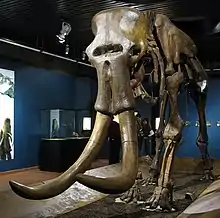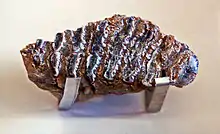Steppe mammoth
The steppe mammoth (Mammuthus trogontherii, sometimes Mammuthus armeniacus) is an extinct species of mammoth that ranged over most of northern Eurasia during the Early and Middle Pleistocene, approximately 1.8 million-200,000 years ago. It evolved in East Asia during the Early Pleistocene, around 1.8 million years ago, before migrating into North America around 1.5 million years ago, and into Europe during the Early/Middle Pleistocene transition, around 1 to 0.7 million years ago. It was the ancestor of the woolly mammoth and Columbian mammoth of the later Pleistocene. Populations of steppe mammoth may have persisted in northern China and Mongolia as late as 33,000 years ago.
| Steppe mammoth Temporal range: Early-Mid Pleistocene Possible Late Pleistocene record | |
|---|---|
 | |
| Skeleton | |
.png.webp) | |
| Skeletal diagram of the 3.89 metre tall Zhalainuoer III specimen | |
| Scientific classification | |
| Domain: | Eukaryota |
| Kingdom: | Animalia |
| Phylum: | Chordata |
| Class: | Mammalia |
| Order: | Proboscidea |
| Family: | Elephantidae |
| Genus: | †Mammuthus |
| Species: | †M. trogontherii |
| Binomial name | |
| †Mammuthus trogontherii (Pohlig, 1885) [1] | |
| Synonyms | |
| |
Taxonomy

There was historically confusion about the correct scientific name for the steppe mammoth, either Mammuthus armeniacus (Falconer 1857) or Mammuthus trogontherii (Pohlig 1885). Falconer used material from Asian sources while Pohlig worked with fossil remains from Europe and both names appear in scientific publications, adding to the confusion. A first taxonomical overhaul was done by Maglio (1973) who decided that both names were synonyms, armeniacus being the older, hence the preferred name.[2] However, in Shoshani & Tassy (1996) it was decided that the description of Pohlig prevailed, and consequently the correct name for the steppe mammoth is M. trogontherii.[3] It is unclear whether both forms are indeed identical and authors tend to use the name M. trogontherii for European material and M. armeniacus for Asian remains.
Several Japanese mammoth varieties from the early Pleistocene have been named, but all are now thought to be synonyms of M. trogontherii.[4]
Genetics
DNA has been sequenced from two Siberian mammoth molars (which judging by morphology belong to the steppe mammoth); at over a million years old, this is the oldest ancient DNA ever recovered. The two genomes recovered belong to separate and distinct lineages: one is ancestral to the woolly mammoth, the other is a previously unknown lineage. The latter lineage hybridized with woolly mammoths at least 420,000 years ago, giving rise to the Columbian mammoth.[5]
Description

With males on average being about 4 m (13.1 ft) tall at the shoulders and about 11 tonnes (10.8 long tons; 12.1 short tons) in weight, M. trogontherii was considerably larger than modern elephants.[6] A skeleton mounted on the Azov Museum reaches 4.5 m (14.8 ft) at the shoulder, though this figure might be overestimated because the vertebrae have been placed between the tips of the shoulder blades.[7] A largely complete specimen (Zhalainuoer III) from Inner Mongolia, China, was estimated to have had a shoulder height of around 3.69 m (12.1 ft) measured at the top of the scapula, which represents a flesh shoulder height of 3.89 m (12.8 ft), with a body mass estimated via volumetric analysis at 10.4 tonnes (10.2 long tons; 11.5 short tons).[8][6] Another individual represented by a single giant humerus 1.46 m (4.8 ft) long and an associated pelvis found in Mosbach Sande, Germany, is estimated to have had a shoulder height of 4.5 metres (14.8 ft) and a weight of 14.3 tonnes (14.1 long tons; 15.8 short tons) via regression analysis.[6]
The skull was high-domed and short, and bore twisted tusks. The lower jaw was short and deep.[8] The number of lamellae on the third molars is around 18–22, noticeably lower than the number typically present in M. primigenius (though some European specimens of M. primigenius have counts which overlap with those of M. trogontherii).[9] The body has around 19 thoracic vertebrae and 5 or 6 sacral vertebrae, with the first few thoracic vertebrae having long neural spines.[8]
Sequenced genomes suggests that Early Pleistocene M. trogontherii specimens from Siberia, around 1 million years old, had already developed many of the genetic changes thought to be responsible for traits that were adaptations for living in cold environments characteristic of woolly mammoths.[5] Due to the cold climates it inhabited and short tail, Mammuthus trogontherii is suggested to have borne a coat of fur, which was probably somewhat thinner than that of the woolly mammoth.[8]
Ecology
Steppe mammoths are thought to have been grazers to grazing-predominant mixed feeders, distinct from Mammuthus meridionalis, whose diet was highly variable but on average included more browse.[10] It was often associated with cold steppe environments, as its common name would suggest, but was not confined to them, as evidenced by the early Middle Pleistocene West Runton Mammoth specimen from Norfolk, England, which was associated with a temperate forested environment.[11]
Evolution
M. trogontherii is suggested to have derived from Mammuthus meridionalis. The oldest records M. trogontherii are known from China, at around 1.8-2 million years ago, from the Nihewan Formation near Majuangou, Hebei. Steppe mammoths arrived in North America across Beringia around 1.5-1.3 million years ago, giving rise to the Columbian mammoth (the ancestor was previously thought to be M. meridionalis but this was due to misinterpretation of tooth wear patterns).[12] Steppe mammoths replaced Mammuthus meridionalis between 1–0.7 million years ago in Europe, in a complex diachronous mosaic pattern. European populations of M. trogontherii experienced a persistent size reduction towards the end of the Middle Pleistocene. A population of M. trogontherii in north east Siberia developed higher tooth plate count after 0.8 mya, reaching M. primigenius (woolly mammoth) morphology by 400,000 years ago.[13] Mammoths with M. primigenius type molar morphology displaced those of M. trogontherii type in Europe over the course of the late Middle Pleistocene, which was largely complete by 200,000 years ago (~MIS 7/6 boundary) in a protracted highly complex pattern that likely reflects regional migration and introgression.[9] Relict populations of M. trogontherii may have persisted in Mongolia and North China well into the Last Glacial Period, with teeth of M. trogontherii like morphology in Shanxi being dated to 33,858–24,857 years BP and Inner Mongolia to c. 33,700 years Before Present.[14]
Relationship with humans
At the Bełchatów coal mine in Poland, dating to the late Middle Pleistocene (in the interglacial period of either MIS 11 or MIS 9), remains of M. trogontherii have been found with cut marks, suggested to represent evidence of butchery by archaic humans.[15] Sites with evidence of both humans and M. trogontherii in Europe are rare, which is suggested to be the result of them primarily occupying different habitats.[16]
See also
References
- Todd, N. E. (January 2010). "New Phylogenetic Analysis of the Family Elephantidae Based on Cranial-Dental Morphology". The Anatomical Record. Wiley-Liss, Inc. 293 (1): 74–90. doi:10.1002/ar.21010. PMID 19937636.
- Maglio, V. J. (1973). "Origin and Evolution of the Elephantidae". Trans Am Philos Soc. 63 (3): 1–149. doi:10.2307/1006229. JSTOR 1006229.
- Shoshani, J.; Tassy, P., eds. (1996). The Proboscidea : Evolution and Palaeoecology of Elephants and Their Relatives. Oxford: Oxford University Press. ISBN 0-19-854652-1.
- van de Greer, Alexandra; Lyras, George; de Vos, John; Dermitzakis, Michael (2011). Evolution of Island Mammals: Adaptation and Extinction of Placental Mammals on Islands (in Danish and English). John Wiley & Sons. p. 240. ISBN 978-1444391282.
- van der Valk, Tom; Pečnerová, Patrícia; Díez-del-Molino, David; Bergström, Anders; Oppenheimer, Jonas; Hartmann, Stefanie; Xenikoudakis, Georgios; Thomas, Jessica A.; Dehasque, Marianne; Sağlıcan, Ekin; Fidan, Fatma Rabia (17 February 2021). "Million-year-old DNA sheds light on the genomic history of mammoths". Nature. 591 (7849): 265–269. Bibcode:2021Natur.591..265V. doi:10.1038/s41586-021-03224-9. ISSN 1476-4687. PMC 7116897. PMID 33597750.
- Larramendi, A. (2016). "Shoulder height, body mass and shape of proboscideans" (PDF). Acta Palaeontologica Polonica. 61. doi:10.4202/app.00136.2014.
- Mol, Dick; van den Bergh, Gert D.; de Vos, John (May 17, 1999), "Fossil Proboscideans from The Netherlands, the North Sea and the Oosterschelde Estuary" (PDF), Mammoths and the Mammoth Fauna: Studies of an Extinct Ecosystem, Deinsea, vol. 6, p. 135, retrieved 15 August 2016
- Larramendi, Asier (June 2015). "Skeleton of a Late Pleistocene steppe mammoth (Mammuthus trogontherii) from Zhalainuoer, Inner Mongolian Autonomous Region, China". Paläontologische Zeitschrift. 89 (2): 229–250. doi:10.1007/s12542-014-0222-8. ISSN 0031-0220.
- Lister, Adrian M. (October 2022). "Mammoth evolution in the late Middle Pleistocene: The Mammuthus trogontherii-primigenius transition in Europe". Quaternary Science Reviews. 294: 107693. Bibcode:2022QSRv..29407693L. doi:10.1016/j.quascirev.2022.107693. S2CID 252264887.
- Rivals, Florent; Semprebon, Gina M.; Lister, Adrian M. (September 2019). "Feeding traits and dietary variation in Pleistocene proboscideans: A tooth microwear review". Quaternary Science Reviews. 219: 145–153. Bibcode:2019QSRv..219..145R. doi:10.1016/j.quascirev.2019.06.027. S2CID 200073388.
- Lister, Adrian M.; Stuart, Anthony J. (December 2010). "The West Runton mammoth (Mammuthus trogontherii) and its evolutionary significance". Quaternary International. 228 (1–2): 180–209. doi:10.1016/j.quaint.2010.07.032.
- Lister, A. M.; Sher, A. V. (2015-11-13). "Evolution and dispersal of mammoths across the Northern Hemisphere". Science. 350 (6262): 805–809. Bibcode:2015Sci...350..805L. doi:10.1126/science.aac5660. ISSN 0036-8075. PMID 26564853. S2CID 206639522.
- Lister, Adrian M.; Sher, Andrei V.; van Essen, Hans; Wei, Guangbiao (January 2005). "The pattern and process of mammoth evolution in Eurasia". Quaternary International. 126–128: 49–64. Bibcode:2005QuInt.126...49L. doi:10.1016/j.quaint.2004.04.014. ISSN 1040-6182.
- Wei, GuangBiao; Hu, SongMei; Yu, KeFu; Hou, YaMei; Li, Xin; Jin, ChangZhu; Wang, Yuan; Zhao, JianXin; Wang, WenHua (2010-06-09). "New materials of the steppe mammoth, Mammuthus trogontherii, with discussion on the origin and evolutionary patterns of mammoths". Science China Earth Sciences. 53 (7): 956–963. Bibcode:2010ScChD..53..956W. doi:10.1007/s11430-010-4001-4. ISSN 1674-7313. S2CID 129568366.
- Haynes, Gary (March 2022). "Late Quaternary Proboscidean Sites in Africa and Eurasia with Possible or Probable Evidence for Hominin Involvement". Quaternary. 5 (1): 18. doi:10.3390/quat5010018. ISSN 2571-550X.
- Konidaris, George E.; Tourloukis, Vangelis (2021-04-14). "Proboscidea-Homo interactions in open-air localities during the Early and Middle Pleistocene of western Eurasia: a palaeontological and archaeolocigal perspective". Human-Elephant Interactions: From Past to Present. doi:10.15496/publikation-55599.
Further reading
- Benes, Josef (1979). Prehistoric Animals and Plants. London: Hamlyn. p. 271. ISBN 0-600-30341-1.
- Augusti, Jordi; Anton, Mauricio (2002). Mammoths, Sabertooths and Hominids 65 Million Years of Mammalian Evolution in Europe. Columbia University Press. ISBN 0-231-11640-3.
- Lister, Adrian; Bahn, Paul (1997). Mammuts : Riesen der Eiszeit (in German). Sigmaringen: Thorbecke Verlag. ISBN 3-7995-9050-1.
- Mol, Dick; Lacombat, Frédéric (2010). Mammoths & Mastodons of Haute-Loire. Drukware. p. 271. ISBN 978-2-911794-97-1. (English and French)